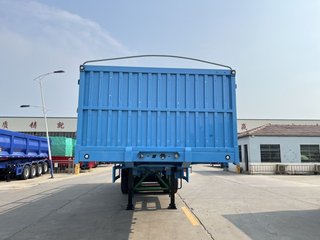Semi-Trailer Suppliers: Who They Are & Why They Matter

Semi-trailers include the backbone of land freight transport—moving sets from food, machinery, and chemicals to construction materials and consumer goods. Trailer manufacturing company include the companies designing, manufacturing, distributing, and supporting these vehicles, in addition to their performance has big effects on cost, reliability, safety, and sustainability for logistics and transport operators.
What to Look for in the Semi-Trailer Supplier
For companies (fleets, logistics operators) selecting a supplier, there are several critical criteria:

Build Quality & Materials
Steel strength and type, welding quality.
Corrosion protection (paint, galvanization).
Suspension and axle quality—especially in harsh road or conditions.
Regulatory Compliance & Safety Features
Lighting, brakes, anti-rollover protection, underrun guards, etc.
Conformity with local regulations for weight limits, dimensions, axle loads.
Certifications (e.g. in EU, OEM standards, etc.).
After-Sales Support & Spare Parts
Availability of spare parts locally.
Service network: repair, maintenance.
Skill/training support for technicians.
Customization & Flexibility
Ability to modify dimensions, deck height, sidewalls, types (flatbed, tipper, reefer, etc.).
Variants fitted to the environment (e.g. for unpaved roads, steep terrain, etc.).
Efficiency & Operating Costs
Weight of trailer (lighter = more payload, lower fuel consumption).
Aerodynamics (in most designs) and drawbar/kingpin features.
Fuel-saving and running cost factors (tyres, lubrication, maintenance frequency).
Technology & Innovation
Telemetry, sensors (tire pressure, load weight, temperature).
Integration possibilities (e.g. cold chain monitoring, tracking).
Energy-saving features, materials, maybe smart trailer features.
Price, Lead Time, and Reliability
Total expense of ownership, not only purchase price.
Delivery time, consistency.
Supplier reliability—how well they deliver promised specs and support.
Trends & Drivers Shaping Semi-Trailer Suppliers
What is evolving in the industry — they're factors that suppliers must conform to:
Growing Demand for Refrigerated / Cold-Chain Trailers
As perishable goods and pharmaceuticals increase, there exists elevated need for reefers with increased stringent temperature control, hygiene (antimicrobial interiors, etc.).
Lightweight Materials & Fuel Efficiency
To reduce fuel consumption (which is a large share of operating cost), lighter but durable materials, better aerodynamics, and smarter designs are getting to be more important.
Sustainability & Regulations
Governments tightening emissions, weight/size, noise and environmental regulations. Suppliers have to meet environmental standards in materials, emissions of associated transport operations, etc.
Digitalization, Telematics & Smart Features
More trailers are equipped with sensors (temperature, brake status, door status), GPS tracking, diagnostics, predictive maintenance tools. These lessen downtime, avoid breakdowns.
Intermodal / Multimodal Transport
Semi-trailers that will easily transfer between truck, rail, and ship modes (or perhaps be more appropriate for containerization) are increasingly valuable.
Regionalization & Local Assembly
To spend less (shipping, import duties), reduce lead times, improve service and parts support, many suppliers are establishing local plants or partnerships. Suppliers that can do localization often win in numerous markets. (Not always uniform everywhere, but a definite trend.)
Regional Dynamics & Important Markets
Europe
Heavily regulated; high standards for safety, emissions, dimensions; many strong local manufacturers (Schmitz, Krone, Wielton etc.). Buyers expect compliance, good after-sales, and durable designs.
North America
Large market, with strong interest in dry vans, reefers, specialized transport. Importance added to fuel efficiency, regulatory compliance (e.g. weight, highway rules), and service network.
Asia / China / India
Rapid growth in both manufacturing and demand. Lower expense of production, many suppliers, increasing quality. A lot of export-oriented production. Also growing domestic demand and stricter regulations needs to apply.
Africa / Latin America / Emerging Regions
Key concerns are durability (roads often rough), simplified maintenance, availability of spare parts, cost and value. Suppliers that could tailor trailers for rough roads, hot temperature, dust, minimal service infrastructure usually succeed. Also, import duties and logistics cost is very relevant.
Challenges for Suppliers
While there is certainly opportunity, suppliers also face several challenges:
Raw Material Costs & Supply Chain Disruptions
Steel, aluminium, components (axles, brakes, electronics) could possibly have volatile prices or delays. If supply chains are disrupted (e.g. on account of geopolitics or logistic bottlenecks), deliveries suffer.
Regulatory & Certification Barriers
Different countries have different rules for axle load, dimensions, safety equipment, lighting. Getting approvals and certifications might be expensive and time-consuming.
Competition & Price Pressure
Many suppliers (specially in China and other lower-cost countries) undercut on price. High end or premium suppliers must prove value to justify cost.
After-Sales Support in Remote Areas
If you're buying trailers for remote regions, getting parts, repairs, and service may be hard. Suppliers must spend money on networks or partnerships.
Technology Adoption & Costs
Adding sensors, telematics, advanced materials increases cost. Some customers may balk at upfront costs, even though total cost of ownership is lower long-term.
Environmental / Sustainability Requirements
Increasing pressure from governments and customers to reduce carbon footprint in the lifetime of the trailer (materials, production, usage). This forces investment in R&D.
Opportunities & What Makes to get a Strong Supplier
Suppliers that are likely to excel are those who:
Combine durability & cost-effectiveness (suitable for local road/operating conditions).
Offer strong after-sales support—spare parts, servicing, accessible training.
Can customize to customer needs.
Embrace tech like telematics, sensors, predictive maintenance.
Reduce weight and fuel consumption.
Work with sustainable practices (material sourcing, manufacturing, emissions).
Localize production or setup assembly / parts hubs in key markets.
Outlook
The semi-trailer supply marketplace is expected to grow solidly in future years. Some market reports estimate continued growth with a CAGR of ~5-7% depending on region.
Key forces that may drive that growth are:
Expansion of e-commerce and fast delivery services.
Growth in cold-chain logistics for food, pharmaceuticals.
Infrastructure investments (roads, highways, intermodal terminals).
Stronger regulatory push for sustainability and safety.
At one time, innovation and efficiency gains will likely be essential for suppliers to remain competitive.
